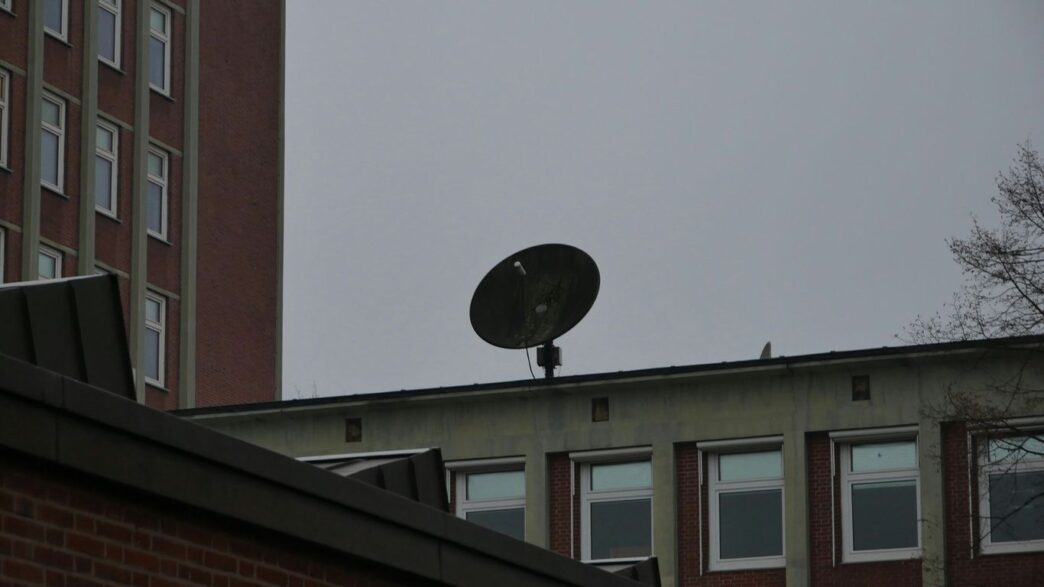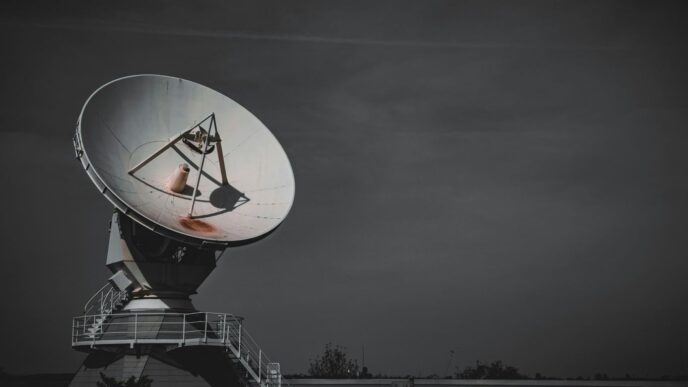It feels like just yesterday we were talking about phones not being able to get a signal in the middle of nowhere. Now, T-Mobile and Starlink are changing that. They’ve teamed up to bring cell service, and even some app access, through satellites. This whole t-mobile starlink thing could really change how we stay connected, especially when we’re out of town or in places without regular cell towers. Let’s check out what’s going on with this new satellite connectivity.
Key Takeaways
- T-Mobile’s T-Satellite service, powered by Starlink, officially launched commercially in July 2025, offering messaging and app access via around 650 satellites.
- The service is available at no extra cost on T-Mobile’s Experience Beyond plan, with other T-Mobile customers and those on AT&T and Verizon paying an additional $10 per month.
- Ookla data from late 2024 to mid-2025 shows T-Mobile customers making up the majority of Starlink D2D connections, though AT&T users also show significant interest.
- While T-Mobile’s fixed internet speeds haven’t been affected, SpaceX is working on improving direct-to-device data speeds, aiming for levels comparable to 4G LTE.
- Competitors like AT&T and Verizon are also exploring satellite partnerships, with companies like Skylo and AST SpaceMobile working on similar direct-to-device services.
T-Mobile Starlink: A New Era of Connectivity
The Genesis of T-Mobile Starlink Partnership
It feels like just yesterday we were talking about the possibility, and now it’s here. T-Mobile and SpaceX joined forces, and the result is something pretty wild: letting regular smartphones connect directly to Starlink satellites. This partnership is all about filling in the gaps where traditional cell service just can’t reach. They’re using a slice of T-Mobile’s own airwaves to make this happen, which is a pretty clever move. It’s not just about emergency texts anymore; it’s about keeping you connected, period. This whole thing started brewing back in August 2022, and it’s been a rapid development since then, especially with the commercial launch in July 2025. It’s a big step for mobile connectivity.
Commercial Launch and Early Adoption
So, the T-Satellite service officially went live in July 2025. Initially, it was all about text messages and texting 911, which, honestly, has already proven to be a lifesaver in a few situations. But they didn’t stop there. T-Mobile quickly expanded the service to include app-based voice, video, and data. This means you can now use apps like WhatsApp, X, and AllTrails even when you’re way out in the sticks. The response has been pretty strong, with T-Mobile customers making up a significant chunk of the early users. It’s interesting to see how other carriers’ customers are jumping in too, showing that the need for this kind of coverage is widespread.
Impact on Rural and Remote Areas
This is where T-Mobile Starlink really shines. Think about all those places that have spotty or no cell service at all – national parks, remote cabins, long stretches of highway. Now, people in those areas can have a reliable connection. It’s not just for convenience; it’s a huge deal for safety. First responders can stay in touch, hikers can check in, and families can connect even when they’re far from civilization. We’re seeing data showing activity in places like Los Angeles County, which has both urban areas and vast wilderness, highlighting how this service bridges the gap between the connected city and the unconnected outdoors. It’s a game-changer for anyone who lives, works, or plays outside of traditional network coverage zones.
Understanding T-Mobile’s T-Satellite Service
So, how does this whole T-Mobile and Starlink thing actually work for us regular folks? It’s pretty neat, actually. T-Mobile’s T-Satellite service uses Starlink’s satellites, specifically the ones designed for direct-to-device communication. Think of it as a bridge connecting your regular smartphone to the satellite network when you’re way out of cell range. This service is designed to keep you connected for essential communication, even when there’s no cell tower around.
How T-Satellite Leverages Starlink Satellites
Basically, T-Mobile partnered with SpaceX, the company behind Starlink. They’ve put up a bunch of satellites, over 650 of them now, that can talk directly to your phone. It’s not like the old days where you needed a special satellite phone. Your current smartphone, if it’s a relatively new one (usually from the last couple of years), can connect to these satellites. It’s a pretty clever setup that uses the existing Starlink constellation, but with a specific focus on connecting directly to mobile devices.
Service Availability and Pricing Tiers
Getting T-Satellite isn’t quite the same for everyone, and the cost can vary. If you’re on T-Mobile’s top-tier ‘Experience Beyond’ plan, which is already pretty pricey starting at $100 a month, you get T-Satellite included at no extra charge. For other T-Mobile customers, it was offered for free for a bit, but now it’s generally an extra $10 per month. What’s interesting is that even if you’re not a T-Mobile customer, you can still get it. AT&T and Verizon customers can sign up for an additional $10 monthly fee, though they might have to go through a T-Mobile store or call customer service to set it up. Non-T-Mobile users can also get it via an eSIM.
Here’s a quick look at how it breaks down:
| Plan Type | Carrier | Cost (Monthly) | Notes |
|---|---|---|---|
| Experience Beyond | T-Mobile | Included | For existing T-Mobile customers |
| Other T-Mobile Plans | T-Mobile | $10 | After initial promotional period |
| AT&T / Verizon Customers | AT&T / Verizon | $10 | Requires T-Mobile activation |
| Non-Carrier Specific | N/A | $10 | Available via eSIM |
Supported Devices and Application Access
This service works with most newer smartphones, both iPhones and Androids, released in the last two to four years. You don’t need a special phone, which is a big deal. Initially, it was mainly for texting and emergency calls to 911. But they’ve been adding more capabilities. Now, you can use certain apps over the satellite connection. T-Mobile has worked with app developers to make sure things like:
- Messaging apps: Like WhatsApp and X (formerly Twitter), so you can send messages and browse basic content.
- Navigation and outdoor apps: AllTrails and CalTopo are on the list, letting you check maps and routes.
- Information apps: AccuWeather for forecasts and T-Mobile’s own T-Life app for location sharing and support.
While the speed won’t match your 5G at home, it’s enough for these essential functions. It’s all about making sure you can get critical information or reach out when you’re truly off the grid. They’re even looking at business uses, with plans for enterprise and government clients needing always-on connections.
T-Mobile Starlink Usage Data and Trends
Analyzing Connection Share Across Carriers
So, who’s actually using this T-Mobile Starlink service? Well, the data from Ookla’s Speedtest network gives us a pretty good picture. As of September 2025, T-Mobile customers were the biggest group signing up, making up about 60.9% of all connections. That’s a solid chunk, right? But here’s the interesting part: AT&T customers were also showing a lot of interest, grabbing a 34% share. It seems like people are willing to try out the service regardless of their primary carrier. Verizon customers, on the other hand, were way behind, with only about 2.2% of connections. This might be because Verizon already has its own satellite texting deal with Skylo, so their customers might not see as much need to switch or add another service.
When you look specifically at Android devices that had an active service connection at the time they linked up with Starlink, T-Mobile’s share actually jumped even higher, to around 70.8%. This suggests that for those actively using the service, T-Mobile customers are even more dominant.
| Carrier | Connection Share (Dec 2024 – Sep 2025) | Connection Share (Active Service Only) |
|---|---|---|
| T-Mobile | 60.9% | 70.8% |
| AT&T | 34.0% | N/A |
| Verizon | 2.2% | N/A |
| FirstNet | 3.0% | N/A |
Geographic Hotspots for T-Satellite Activity
Where are people using this satellite service the most? According to the data, Los Angeles County in California has been the top spot for T-Satellite activity. This makes sense when you think about it – it’s a huge area with both a massive city and large, rugged natural spaces like the Angeles National Forest. These are exactly the kinds of places where regular cell service can be spotty at best. It’s also worth noting that T-Mobile had actually deployed free T-Satellite services in this area early in 2025, especially during wildfire season, which likely boosted early adoption and usage.
Other counties that showed up with significant T-Satellite activity include Larimer County in Colorado, Teton County in Wyoming, Mohave County in Arizona, and Mineral County in Montana. These are all areas known for outdoor recreation and remote living, further highlighting the service’s appeal in places where traditional mobile coverage struggles.
Growth in Direct-to-Device Connections
Since its commercial launch in July 2025, the number of devices connecting directly to Starlink satellites has been steadily climbing. While the exact numbers fluctuate week by week, the overall trend shows a clear increase in adoption. This growth is happening across different carriers, though T-Mobile users are leading the pack. It’s still early days for this technology, so we’re seeing a lot of learning happening, both from the companies providing the service and from users figuring out how their phones work with it. The steady rise in direct-to-device connections indicates a growing reliance on satellite technology for basic communication needs, especially in areas previously underserved by traditional networks.
It’s important to remember that the satellites used for this direct-to-device service are separate from those used for Starlink’s fixed home internet. This means that the increased use of T-Satellite hasn’t negatively impacted the speeds or performance of Starlink’s internet service for existing home users, which is good news for everyone.
The Technical Backbone of T-Mobile Starlink
So, how does this whole T-Mobile and Starlink thing actually work? It’s pretty interesting, really. We’re not just talking about a few satellites up there; it’s a whole system designed to keep you connected when you’re way off the grid.
Satellite Technology Beyond Fixed Internet
First off, it’s important to know that the satellites T-Mobile is using for this direct-to-device service aren’t the same ones powering Starlink’s home internet. SpaceX has a separate fleet for this. Think of it like having different lanes on a highway; one lane is for the fast home internet, and another is specifically for your phone. This separation means that even with all these phones connecting, your home Starlink speeds shouldn’t take a hit. Pretty smart, right?
- Dedicated Satellites: Starlink has a growing number of satellites specifically designed for direct-to-device communication.
- Different Frequencies: These satellites use different radio frequencies than those used for fixed broadband.
- Shared Backhaul: While the satellites are different, they do share the same ground infrastructure, or backhaul, to get data to and from the internet.
Future Enhancements and Data Speed Aspirations
Right now, the T-Satellite service is mostly about texting and a few specific apps like weather and maps. It’s not exactly blazing fast, but it’s functional. T-Mobile and SpaceX are aiming higher, though. They’re looking at ways to boost speeds and expand what you can do. Imagine being able to stream a video or have a video call from a remote mountain top – that’s the kind of thing they’re working towards.
- Initial Focus: Texting and basic app access.
- Next Steps: Increasing data speeds for more complex applications.
- Long-Term Goal: Enabling richer multimedia communication and potentially even voice calls over satellite.
Spectrum Acquisition and Future Satellite Deployments
To make all this happen, especially for faster data speeds, having the right radio frequencies, or spectrum, is key. T-Mobile is already working on this. They’re looking at acquiring more spectrum and deploying newer, more capable satellites. This means more capacity and better performance down the line. It’s a continuous process of upgrading the technology to keep up with demand and new possibilities. The more spectrum they have, the more data can be sent and received simultaneously.
- Spectrum Strategy: Acquiring and utilizing appropriate radio frequencies.
- Satellite Upgrades: Planning for next-generation satellites with enhanced capabilities.
- Global Expansion: Working with international partners to extend the service beyond the US.
Competitive Landscape and Future Outlook
T-Mobile Starlink vs. Other Satellite Offerings
So, T-Mobile and Starlink are teaming up, but they’re not exactly alone in the satellite game. You’ve got other players out there, like Apple using Globalstar for its iPhone messaging. Globalstar is even planning a new constellation to do more than just text. Then there’s AST SpaceMobile, which has deals with AT&T and Verizon to offer messaging, voice, and data from space. It’s a crowded field, and everyone’s trying to figure out the best way to connect us when we’re off the grid.
Potential Impact on Traditional Mobile Carriers
Will this shake things up for the big carriers? Elon Musk seems to think Starlink could eventually be like another carrier, like AT&T or Verizon. But he also says they won’t put the others out of business because those companies still own a lot of spectrum. SpaceX’s Gwynne Shotwell mentioned they’ll be talking to telcos differently now, maybe offering them wholesale capacity. It sounds like they want to work with the carriers, not necessarily replace them. Still, it’s a new option for customers, and that always makes the established players pay attention.
The Evolving Role of Satellite in Mobile Networks
It’s pretty clear that satellites are becoming more than just for internet in remote places. We’re seeing a shift towards direct-to-device (D2D) services, connecting your regular phone right to a satellite. This is especially useful for those times you’re completely out of cell service – maybe you have a flat tire way out in the sticks or you’re hiking and twist an ankle. Even if it’s only a small percentage of the time people are disconnected, those are often the moments when a connection is most needed. Surveys show people are willing to pay a decent amount each month for this kind of backup. It’s not about super-fast speeds right now, more about having that lifeline when it counts. But the goal is to get faster, with some companies aiming for speeds similar to 4G LTE. It’s a big change from just having satellite phones for emergencies.
The Road Ahead
So, what does all this mean for the future? It looks like T-Mobile and Starlink are really onto something here. We’re seeing more and more people signing up, even folks from other phone companies. It’s still early days, and sure, the speeds aren’t going to blow you away for heavy internet use, but for staying in touch when you’re way out there? It’s a pretty big deal. This partnership is changing how we think about staying connected, proving that even in the most remote spots, a signal might just be a satellite away. It’s exciting to see where this goes next, especially as they plan to add more services beyond just texting.
Frequently Asked Questions
What is T-Mobile’s T-Satellite service?
T-Mobile’s T-Satellite service is a way to send texts and use some apps even when you don’t have a regular cell signal. It works by connecting your regular smartphone directly to Starlink satellites in space. Think of it as a backup connection for when you’re really far from any cell towers, like when you’re hiking in the mountains or in a remote area.
How does T-Satellite use Starlink satellites?
T-Mobile has teamed up with SpaceX, the company that runs Starlink. SpaceX has launched special satellites that can talk directly to your phone. When your phone can’t find a cell tower, it can automatically connect to one of these Starlink satellites to send and receive messages and use certain apps.
Who can use T-Satellite, and how much does it cost?
T-Mobile customers on certain plans, like the ‘Experience Beyond’ plan, can use T-Satellite at no extra charge. Other T-Mobile customers, and even customers from AT&T and Verizon, can add the service for about $10 per month. If you don’t have T-Mobile, you can still get it using an eSIM.
What kind of phones work with T-Satellite?
Most newer smartphones, both iPhones and Android phones released in the last 2 to 4 years, can work with T-Satellite. You usually don’t need a special phone or case; your existing phone should be able to connect as long as it’s compatible with the service.
Can I use T-Satellite for high-speed internet or phone calls?
Right now, T-Satellite is mainly for texting and using a limited number of basic apps like messaging and maps. It’s not designed for fast internet browsing or making regular phone calls. T-Mobile is working on adding more features, but for now, it’s best for essential communication when you’re out of regular service areas.
What happens if I’m in an area with no signal?
If your phone loses its regular cell signal, T-Satellite is designed to connect automatically. You don’t usually need to do anything. Your phone might take a moment to find a satellite, so if it doesn’t connect right away, just wait a little bit and try again. It’s meant to be a reliable way to stay in touch when you’re off the grid.














